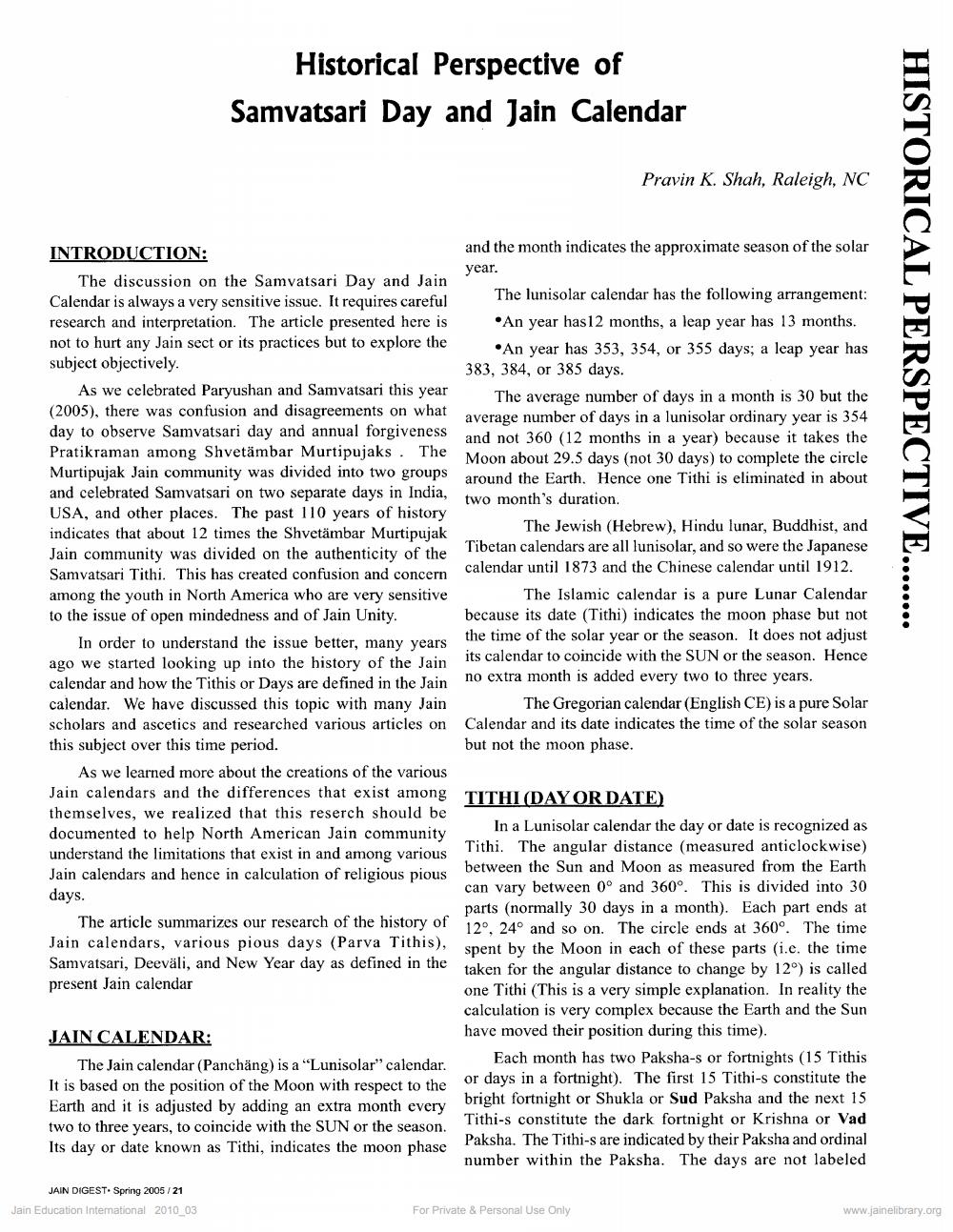________________
Historical Perspective of Samvatsari Day and Jain Calendar
Pravin K. Shah, Raleigh, NC
HISTORICAL PERSPECTIVE
INTRODUCTION:
and the month indicates the approximate season of the solar
year. The discussion on the Samvatsari Day and Jain Calendar is always a very sensitive issue. It requires careful
The lunisolar calendar has the following arrangement: research and interpretation. The article presented here is An year has 12 months, a leap year has 13 months. not to hurt any Jain sect or its practices but to explore the
•An year has 353, 354, or 355 days; a leap year has subject objectively.
383, 384, or 385 days. As we celebrated Paryushan and Samvatsari this year The average number of days in a month is 30 but the (2005), there was confusion and disagreements on what
average number of days in a lunisolar ordinary year is 354 day to observe Samvatsari day and annual forgiveness
and not 360 (12 months in a year) because it takes the Pratikraman among Shvetämbar Murtipujaks. The
Moon about 29.5 days (not 30 days) to complete the circle Murtipujak Jain community was divided into two groups
around the Earth. Hence one Tithi is eliminated in about and celebrated Samvatsari on two separate days in India,
two month's duration USA, and other places. The past 110 years of history indicates that about 12 times the Shvetämbar Murtipujak
The Jewish (Hebrew), Hindu lunar, Buddhist, and Jain community was divided on the authenticity of the
he Tibetan calendars are all lunisolar, and so were the Japanese Samvatsari Tithi. This has created confusion and concern
on and concern calendar until 1873 and the Chinese calendar until 1912.
calendar unt among the youth in North America who are very sensitive
The Islamic calendar is a pure Lunar Calendar to the issue of open mindedness and of Jain Unity because its date (Tithi) indicates the moon phase but not In order to understand the issue better, many years
are the time of the solar year or the season. It does not adjust ago we started looking up into the history of the Jain
its calendar to coincide with the SUN or the season. Hence calendar and how the Tithis or Days are defined in the Jain no extra month is added every two to three years. calendar. We have discussed this topic with many Jain
The Gregorian calendar (English CE) is a pure Solar scholars and ascetics and researched various articles on Calendar and its date indicates the time of the solar season this subject over this time period.
but not the moon phase. As we learned more about the creations of the various Jain calendars and the differences that exist among TITHI (DAY OR DATE) themselves, we realized that this reserch should be
In a Lunisolar calendar the day or date is recognized as documented to help North American Jain community understand the limitations that exist in and among various
Tithi. The angular distance (measured anticlockwise) Jain calendars and hence in calculation of religious pious
between the Sun and Moon as measured from the Earth
can vary between 0° and 360°. This is divided into 30 days.
parts (normally 30 days in a month). Each part ends at The article summarizes our research of the history of 190 240
the history of 12°, 24o and so on. The circle ends at 360o. The time Jain calendars, various pious days (Parva Tithis), SP
spent by the Moon in each of these parts (i.e. the time Samvatsari, Deeväli, and New Year day as defined in the
taken for the angular distance to change by 12°) is called present Jain calendar
one Tithi (This is a very simple explanation. In reality the
calculation is very complex because the Earth and the Sun JAIN CALENDAR:
have moved their position during this time). The Jain calendar (Panchäng) is a "Lunisolar" calendar.
Each month has two Paksha-s or fortnights (15 Tithis It is based on the position of the Moon with respect to the
or days in a fortnight). The first 15 Tithi-s constitute the Earth and it is adjusted by adding an extra month every
bright fortnight or Shukla or Sud Paksha and the next 15 two to three years, to coincide with the SUN or the season.
Tithi-s constitute the dark fortnight or Krishna or Vad Its day or date known as Tithi, indicates the moon phase
Paksha. The Tithi-s are indicated by their Paksha and ordinal number within the Paksha. The days are not labeled
JAIN DIGEST. Spring 2005 / 21 Jain Education Intemational 2010_03
For Private & Personal Use Only
www.jainelibrary.org




